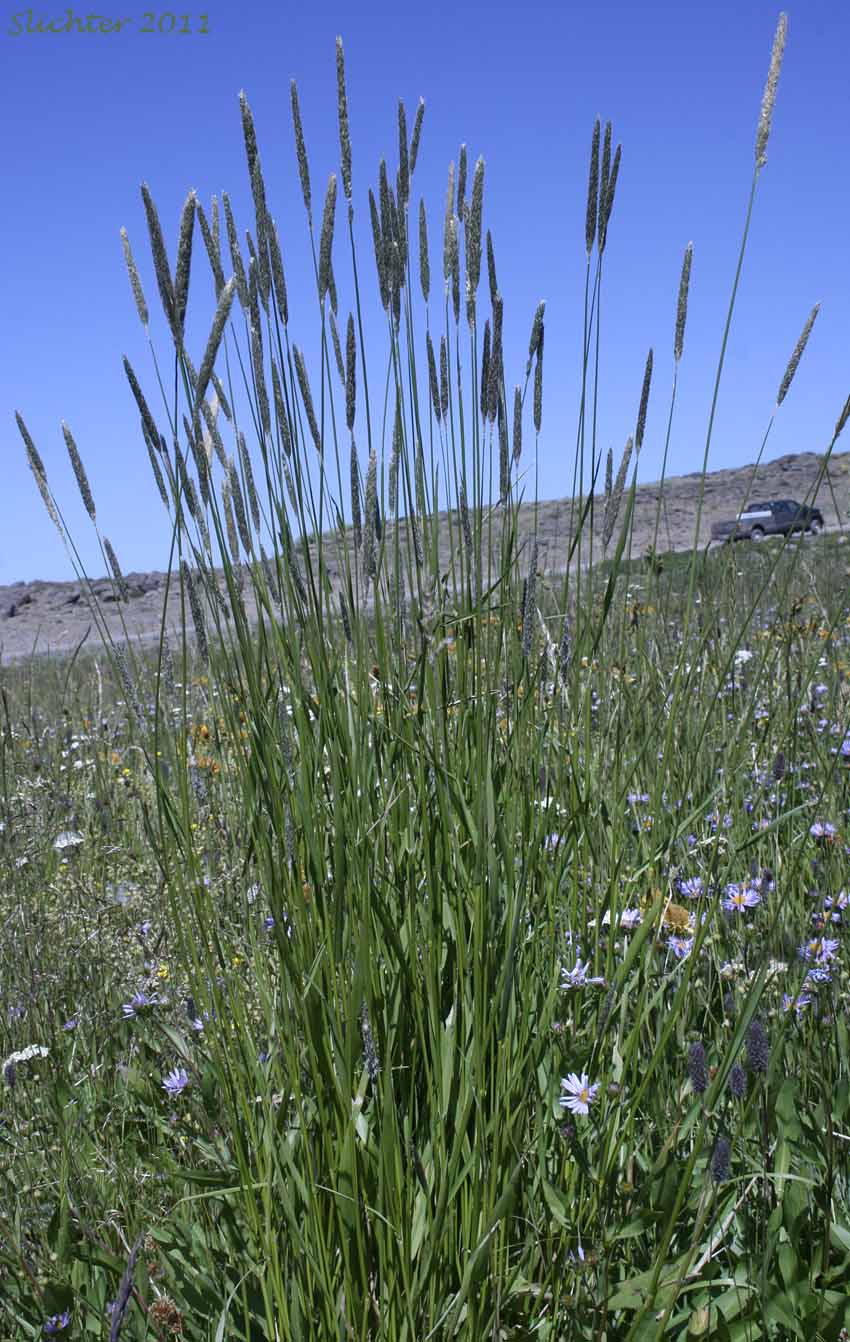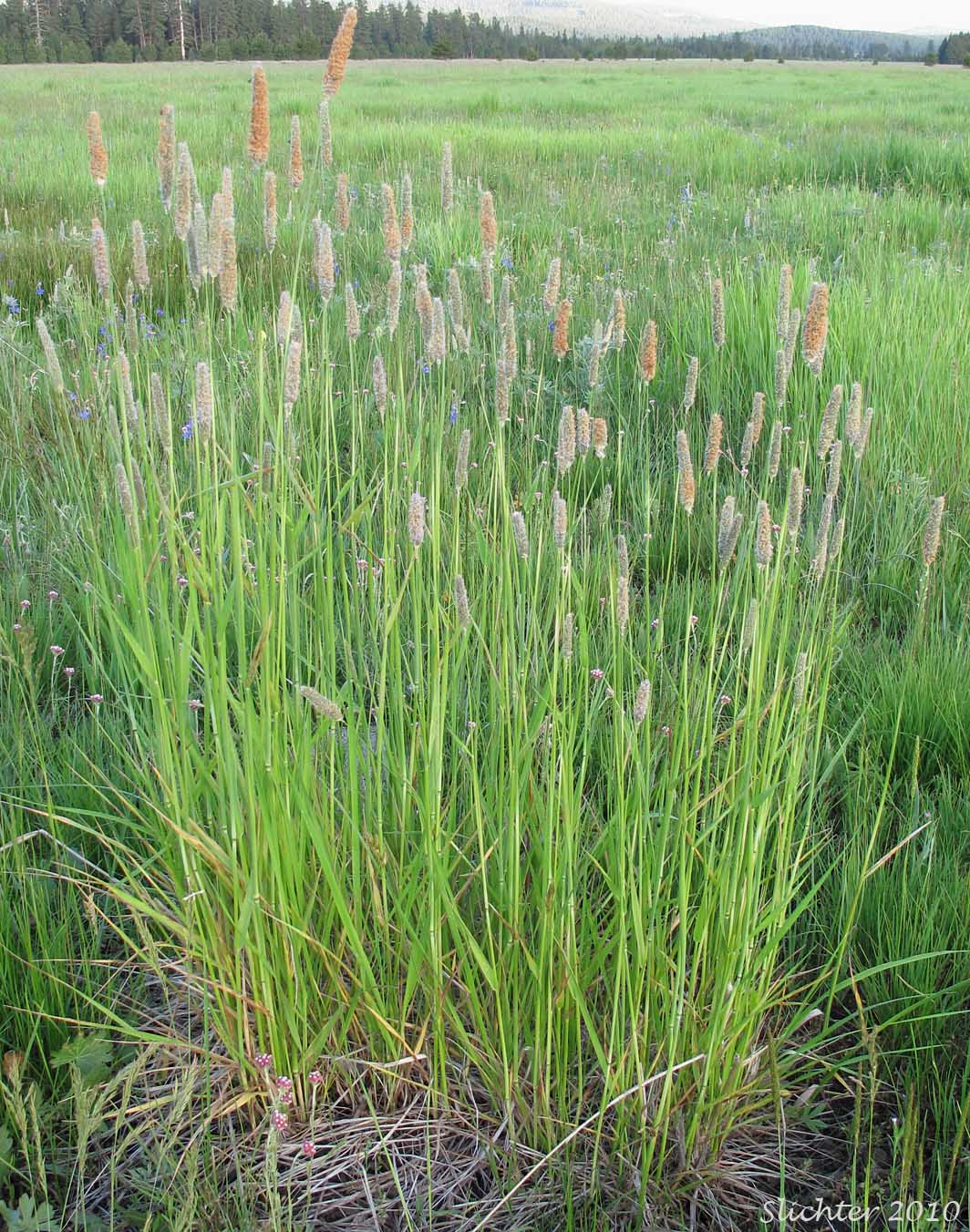Alopecurus pratensis
Meadow Foxtail ( Alopecurus pratensis)
The Meadow Foxtail ( Alopecurus pratensis) is a species of the genus of foxtail grass ( Alopecurus ) in the Gramineae family. He is a perennial grass with high top feed value. The Meadow foxtail is regionally known as donkey grass, dog grass, rat tail, fox tail, hair puller or rye grass.
Description
The Meadow foxtail is a perennial, growing in loose or dense grass clumps. It reaches heights of growth between 30 and 120, sometimes to 150 centimeters. The stalks grow erect or geniculate at base of ascending. The stalks are thin to moderately strong. They have remarkably few nodes are smooth, green or whitish green. The leaf sheaths are smooth, cylindrical, split. The bottom are dark brown, the upper green or whitish- green and are slightly inflated. The glabrous leaf blades are thin tapered, later flat, green, rough, or almost smooth. The lower reach 6-40 inches in length and 3 to 10 millimeters in width. The upper leaves are usually shorter. The entire, membranous ligule ( ligules ) are trimmed slightly and to 2.5 millimeters long.
The Ährenrispen are very dense and cylindrical in outline, about 3 to 12 inches long and up to 10 millimeters wide. They are usually dull green or sometimes crowded purple. The Ährchenstiele are very short and upright. The 5 mm long, flattened spikelets are oblong -elliptic and flowered. They fall when ripe from closed. The glumes are narrow lanceolate and acuminate, three annoying and busy on the keels with thin hair. The lemmas have the same length as the glumes and are ovate to elliptic, obtuse, keeled and four annoying. Furthermore, they have grown from the center to the edges and awned on the back from the lower third forth. The awn protruding from the glumes out about 3 to 5 millimeters. A palea missing. The anthers ( anthers ) are yellow or purple. The fruit ( caryopsis ) is enclosed by the lemma.
The meadow foxtail blooms from April to June or July. Fruit ripening is between July and October.
Distribution and location
The Meadow foxtail is widespread throughout Europe and Northern Asia from the plains to the mountains. The original is not anywhere within the European distribution range grass species has been heavily promoted by the meadow culture.
The meadow foxtail grows preferentially on sickerfeuchten, cool and nutrient-rich, moderately acidic, humus-rich and deep soils. He is a moisture and nutrient pointer and also tolerate partial shade. He is favored by fertilization and irrigation of the site. The grass grows mainly in moist to wet grassland societies. It is the Kennart the plant communities of the European economy meadows ( Molinio - Arrhenatheretea ). It also grows in wet meadows ( Calthion ) and Hochstaudenfluren ( Filipendulion ).
Ecology
The Meadow foxtail is a perennial plant with Horst underground runners.
At the flower is from wind pollination. The vorweiblichen and self- sterile flowers include the " Langstaubfädigen type " and have remarkably not cavernous. The flowering of meadow foxtail applies the German Weather Service as the beginning of hay fever with grass allergies.
Propagation unit are designated as single-flowered spikelets Spelzfrüchte. The glumes serve as a flying machine and they propagate as balloonists. As Anhafter they also serve the random and animal propagation; next man also contributes to the spread. The plant is a light to germinate.
Vegetative propagation is done by up to 10 cm long streamers.
The Meadow foxtail is of the rust fungus Puccinia perplexans with uredia and Puccinia coronata var Telien and coronata infested. The occurrence of Puccinia perplexans seems to be climate-related, but can be influenced by the management especially mulching.
Use
Agriculture
The Meadow foxtail is a profitable at early cut top grass with high feed value ( pasture forage and hay). It is nutritious and palatable for livestock. Upper grasses are tall-growing, rich in flowering and non-flowering Halmtrieben grasses that are intended to suppress the other meadow plants partially under favorable conditions for them. They should bring the mass of the Wiesenheus. These grasses usually are not suitable for permanent grazing.
Medicine
According to a study by the University of Bochum meadow foxtail has a protective effect on the development of allergies - at least in young mice. The researchers found that contains the meadow foxtail the polysaccharide arabinogalactan (see also pectins ), the dendritic cells of the immune system stimulates to produce interleukin 10. Regularly administered intranasally, attenuates IL -10, the immune system and prevents an excessive reaction, without impeding the defense of bacteria and viruses.
Trivial names
More in part only regional common names for the meadow foxtail are or were: Fosswans (Göttingen), pigweed ( Silesia), Fox Wedel (Memmingen ), Röttesteert ( Ostfriesland), Tamgras (North Dithmar ), Taub barley ( Silesia) and Vossensteert ( Low German ).
Pictures
Ährenrispe with purple anthers
Ligule
Illustration








